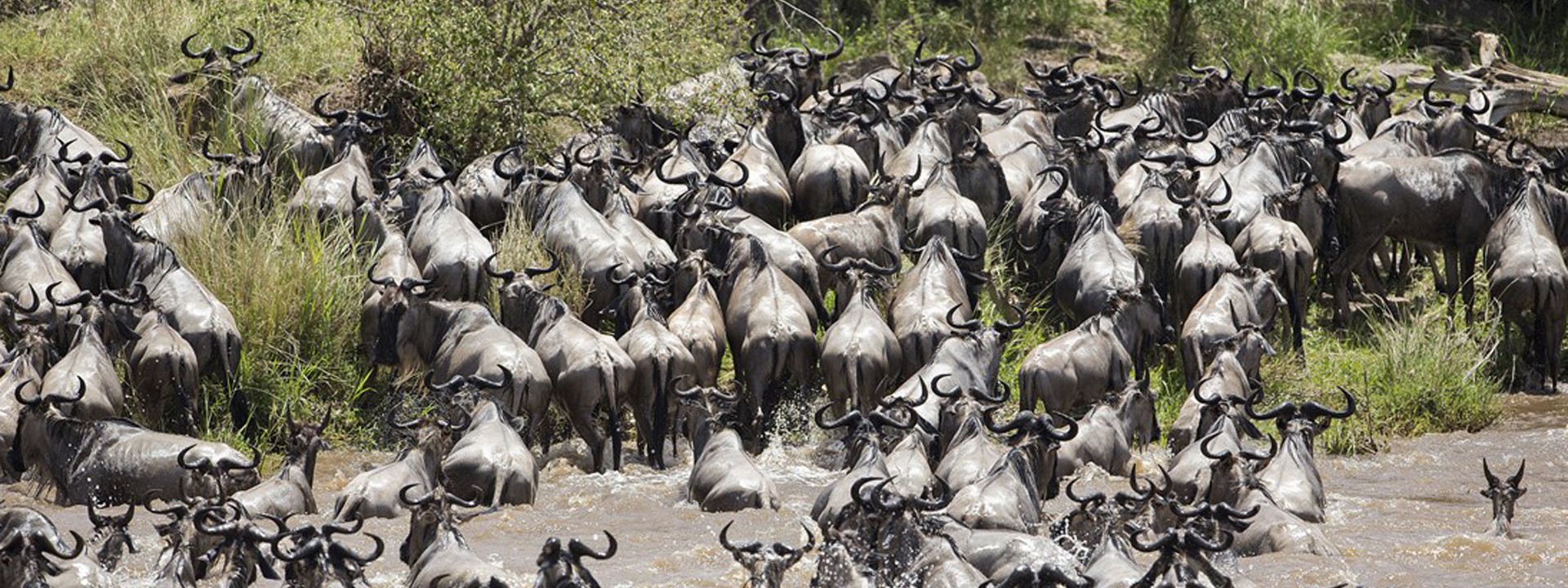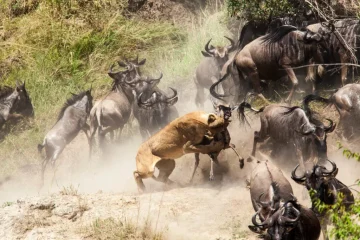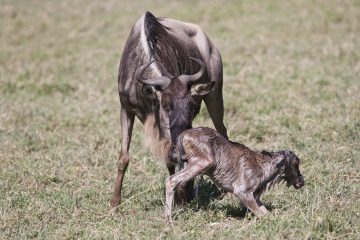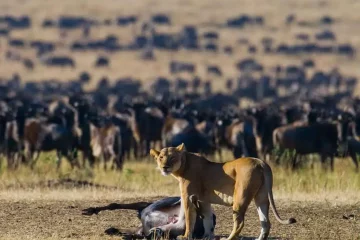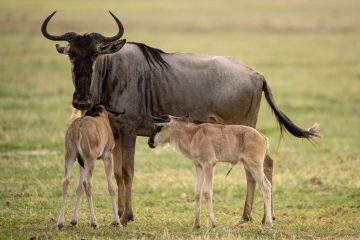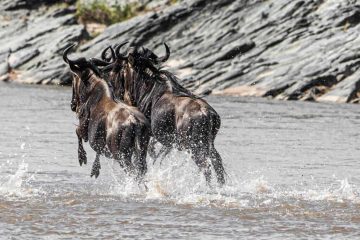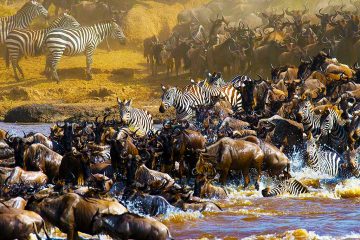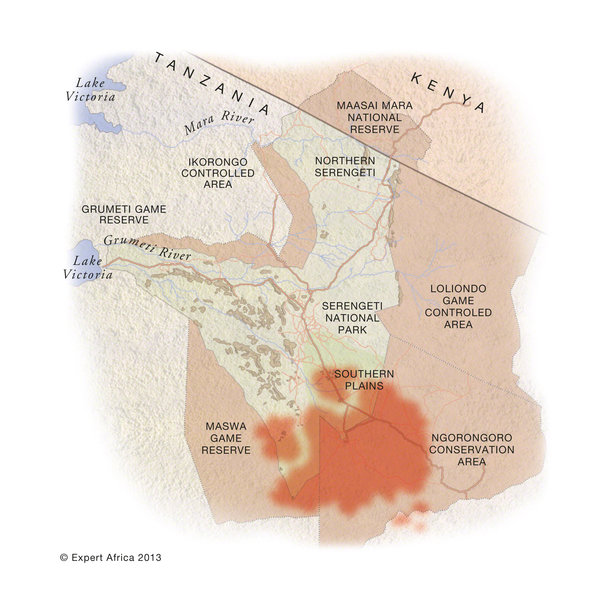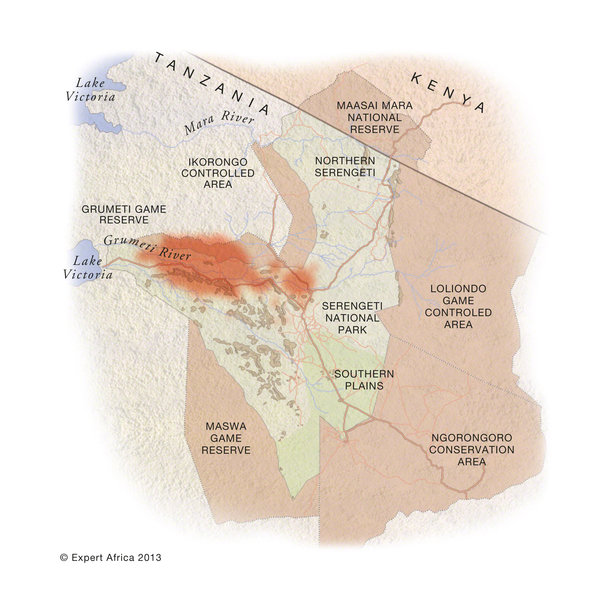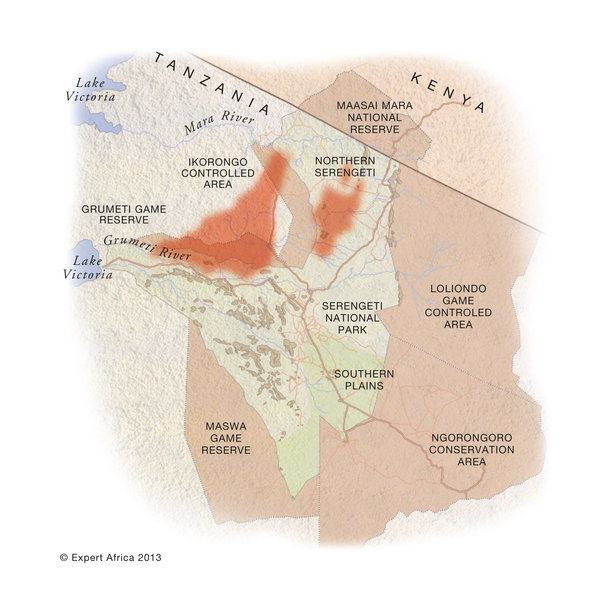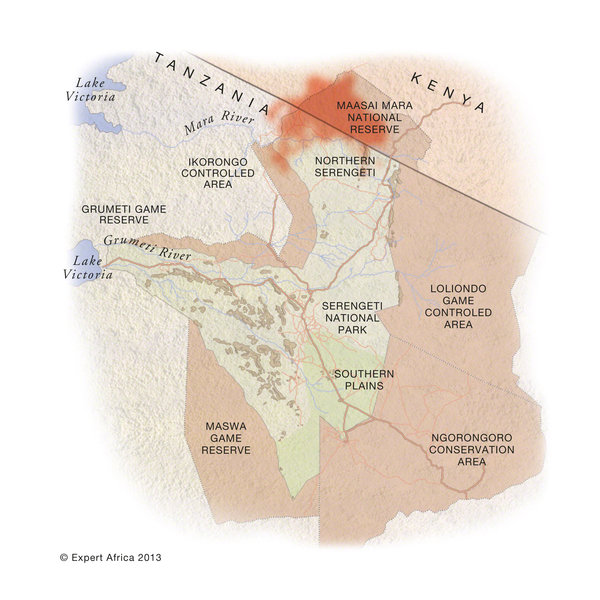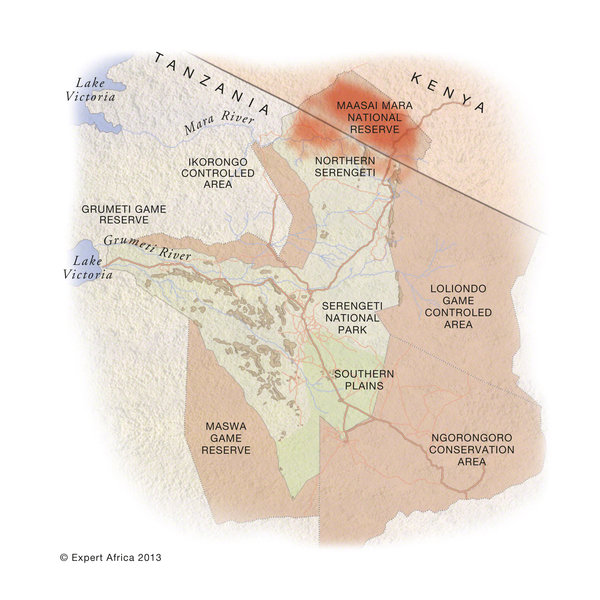Wildebeest River Crossings
Wildebeest river crossings are one of the most dramatic and thrilling events during the Great Wildebeest Migration in East Africa. As the vast herds of wildebeest and zebras journey across the Serengeti National Park in Tanzania and the Maasai Mara National Reserve in Kenya, they often encounter daunting rivers that stand in their path.
During the migration, the wildebeest and zebras must cross several treacherous rivers, with the Mara and Grumeti rivers being the most famous crossing points. These river crossings are essential for the animals to reach greener pastures and to complete their seasonal migration cycle.
The crossings are not only a test of the animals’ physical endurance but also a thrilling spectacle for observers. The sight of thousands of wildebeest and zebras gathering at the riverbank, hesitating, and then finally taking the plunge into the fast-flowing waters is a breathtaking experience. The crossings are fraught with danger as crocodiles lie in wait for an easy meal, and the strong currents can sweep away weaker individuals.
The decision to cross is usually triggered by the leaders of the herds, who bravely enter the river, followed by the rest of the group. The scene quickly turns chaotic as the animals jostle and struggle to make their way to the other side. The loud calls and splashing of water create an exhilarating atmosphere as observers watch in awe.
Wildebeest river crossings are highly unpredictable and can happen at any time during the migration season. It requires patience and luck for safari-goers to witness these awe-inspiring events. However, the reward of witnessing such a natural spectacle is truly unforgettable.
If you are planning to witness wildebeest river crossings, it is advisable to visit the Serengeti and Maasai Mara during the peak migration months between July and October when the herds are most likely to encounter the rivers. Experienced safari guides and tour operators can help you maximize your chances of witnessing this incredible display of nature’s resilience and determination.
Movement of Gnus Between Serengeti & Masai Mara
The movement of gnus (wildebeests) from the Serengeti to the Maasai Mara and back is a fascinating natural phenomenon known as the Great Wildebeest Migration. It is one of the most iconic and awe-inspiring wildlife events in East Africa.
The Great Wildebeest Migration is a cyclical journey undertaken by over two million wildebeests, along with hundreds of thousands of zebras and other herbivores. It is a continuous search for fresh grazing pastures and water sources as the seasons change.
The migration starts in the Serengeti National Park in Tanzania during the dry season, usually around January. The wildebeests gather in large herds on the vast grasslands of the southern Serengeti, where they give birth to their calves. The abundance of food during this time provides them with the nutrients needed for their young ones.
As the dry season progresses and the grass is depleted, the herds start moving towards the northwest, where they encounter the Grumeti River, a significant obstacle in their journey. Here, they must cross the treacherous river, facing the dangers of crocodiles and strong currents.
After crossing the Grumeti River, the herds continue their northward migration, entering the Maasai Mara National Reserve in Kenya, usually around July. The Maasai Mara offers lush, green pastures due to the seasonal rains, making it an attractive feeding ground for the wildebeests.
In the Maasai Mara, the wildebeests experience one of the most thrilling and perilous stages of their migration – the river crossings of the Mara River. Just like in the Serengeti, the river crossings are a test of their strength and endurance, with crocodiles lying in wait.
The herds remain in the Maasai Mara until the end of October or early November, benefiting from the abundant food. As the rains start to recede, they begin their journey back to the Serengeti in Tanzania.
The migration cycle is continuous, as the wildebeests follow the seasonal patterns of rain and grass growth. Their movement is driven by their instinct to survive and find food, and it has been going on for centuries, making it a spectacle that captivates wildlife enthusiasts and photographers from around the world.
Witnessing the Great Wildebeest Migration is a once-in-a-lifetime experience, offering a remarkable insight into the circle of life and the resilience of wildlife in the face of challenges. It is a testament to the incredible wonders of nature and the need to protect these fragile ecosystems for generations to come.
Wildebeest Migration Seasons
The Wildebeest Migration is a continuous, year-round phenomenon in East Africa, involving millions of wildebeests, zebras, and other herbivores. However, it can be broadly divided into two main seasons:
The Dry Season (January to March):
During the early months of the year, typically from January to March, the Wildebeest Migration is centered in the southern Serengeti of Tanzania. This is the calving season, where hundreds of thousands of wildebeests give birth to their young on the vast grasslands of the Serengeti. The abundance of fresh grass and water during this period provides essential nutrients for the newborn calves. This season is marked by large herds gathering in the southern plains.
The Wet Season (June to October):
From June to October, the migration moves northward towards the Maasai Mara in Kenya. This period coincides with the dry season in the Serengeti, where grass and water become scarce. The wildebeests instinctively begin their journey in search of better grazing grounds and water sources. The highlight of this season is the dramatic river crossings of the Grumeti River and the Mara River, as the herds navigate treacherous waters, facing the dangers of crocodiles and strong currents. The Maasai Mara provides lush, green pastures due to the seasonal rains, attracting the wildebeests to its fertile lands.
It’s important to note that migration is a continuous movement, and the exact timing and locations can vary from year to year, depending on factors like rainfall patterns and availability of food and water. The wildebeests’ movement is driven by their instinctual need to find food and survive, resulting in this remarkable and awe-inspiring spectacle that draws wildlife enthusiasts and photographers from around the world. Each season offers unique opportunities to witness different stages of the migration and experience the diverse ecosystems of the Serengeti and Maasai Mara.
When is the best time to see the great Wildebeest migration
The best time to see the Great Wildebeest Migration varies depending on the specific part of the migration you wish to witness:
- Calving Season (January to March): If you want to witness the birthing of wildebeest calves, the calving season from January to March is the ideal time to visit the southern Serengeti in Tanzania. During this period, vast herds of wildebeests gather in the grasslands to give birth. It’s a unique opportunity to see the adorable newborns and witness the predator-prey interactions as predators, like lions and cheetahs, target the vulnerable young.
- River Crossings (June to October): For those seeking the dramatic river crossings, the best time to visit is from June to October. During this period, the migration moves to the Maasai Mara in Kenya, and wildebeests attempt perilous crossings of the Grumeti River and Mara River. These crossings are filled with excitement and danger as wildebeests face the challenges of crocodiles and swift currents. The Maasai Mara offers abundant wildlife and excellent opportunities for witnessing the migration’s breathtaking scenes.
It’s important to remember that the wildebeest migration is a natural and continuous process, with the animals constantly on the move in search of food and water. The exact timing of the migration can vary from year to year, influenced by factors like rainfall patterns and food availability. To ensure the best chances of witnessing the migration, it’s advisable to plan your visit around the general time frames mentioned above. Consulting with experienced safari operators and guides can also be helpful in determining the optimal time to see this awe-inspiring natural spectacle.
Where to see the wildebeest migration
The Great Wildebeest Migration is a magnificent natural spectacle that takes place between the Serengeti National Park in Tanzania and the Maasai Mara National Reserve in Kenya. The wildebeests, accompanied by zebras and other grazers, follow a circular migration route in search of fresh grass and water.
- Serengeti National Park, Tanzania: The Serengeti is where the majority of the wildebeest migration takes place. The vast plains of the Serengeti provide the perfect habitat for the wildebeests to graze and give birth during the calving season. Witnessing the herds stretching as far as the eye can see is an awe-inspiring experience.
- Maasai Mara National Reserve, Kenya: During the dry season, usually from June to October, the wildebeests cross the Mara River into the Maasai Mara. The river crossings are one of the most dramatic events of the migration, attracting numerous predators and offering incredible photo opportunities.
Both the Serengeti and the Maasai Mara are renowned for their diverse wildlife and rich ecosystems, making them prime destinations for wildlife enthusiasts and photographers. Choosing the right time to visit depends on whether you wish to witness the calving season in the Serengeti or the thrilling river crossings in the Maasai Mara.
To experience the full splendor of the Great Wildebeest Migration, it’s recommended to visit both the Serengeti and the Maasai Mara. A well-planned safari in these iconic African destinations will leave you with unforgettable memories of this remarkable natural event.
Month-to-Month Guide
Month-to-Month Guide to the Great Wildebeest Migration:
January to March:
During this period, the herds of wildebeests gather in the southern Serengeti plains for the calving season. Witness the spectacle of thousands of wildebeest calves being born, attracting predators like lions and cheetahs.
April to May:
The rains start to fall, and the herds begin their northward migration towards the central Serengeti. This is a quieter time for tourists, but the landscape is lush and green.
June:
As the dry season begins, the wildebeests continue their journey northwards. By mid to late June, they start arriving at the western corridor of the Serengeti, near the Grumeti River.
July:
The herds make their way to the northern Serengeti, and the river crossings at the Mara River begin. This is a thrilling time to visit, as crocodiles and other predators lie in wait for the wildebeests attempting to cross the treacherous river.
August to October:
The wildebeests are now in the Maasai Mara National Reserve in Kenya, where they continue crossing the Mara River. The predator action is at its peak during this time, making it an ideal period for wildlife enthusiasts and photographers.
November to December:
As the short rains return, the herds start their journey back to the southern Serengeti. This marks the end of the annual migration cycle, and the wildebeests prepare to give birth again, beginning the cycle anew.
Please note that the timing of the migration can vary slightly from year to year, depending on weather patterns and other environmental factors. Therefore, it’s advisable to consult with a reputable safari operator or expert to plan your visit for the best chance of witnessing this incredible natural event.
What to see during the wildebeest migration
During the wildebeest migration, you can witness several incredible sights and natural phenomena as millions of wildebeests, zebras, and other herbivores traverse the Serengeti and Maasai Mara ecosystems. Here are some of the highlights of what you can see during this awe-inspiring event:
- Great Herds of Wildebeests: The migration is one of the most significant wildlife spectacles on Earth, with over a million wildebeests forming massive herds that stretch as far as the eye can see. Watching these animals on their epic journey is a breathtaking experience.
- Dramatic River Crossings: As the wildebeests make their way to the Maasai Mara, they must cross crocodile-infested rivers, most notably the Mara River. These river crossings are high-stakes moments where predators, such as crocodiles and lions, lie in wait to ambush the herds. It’s a heart-pounding sight to witness their determination to reach the other side safely.
- Predator Action: The migration attracts numerous predators, including lions, cheetahs, leopards, and hyenas. These carnivores take advantage of the abundance of prey, resulting in thrilling predator-prey interactions.
- Zebras and Other Herbivores: Alongside the wildebeests, large herds of zebras and other herbivores also participate in the migration. This creates a diverse and dynamic ecosystem on the move.
- Calving Season: In the southern Serengeti, the wildebeests give birth to their young during the calving season. Witnessing the newborn calves taking their first steps is a heartwarming and vulnerable moment in the cycle of life.
- Vast Open Plains: The migration takes place in the vast open plains of the Serengeti and Maasai Mara, offering spectacular views of the African savannah and its diverse wildlife.
- Birdlife: The migration also attracts various bird species, including vultures, eagles, and storks, who follow the herds to scavenge or feed on insects stirred up by the moving masses.
- African Scenery: The wildebeest migration allows you to soak in the beauty of the African landscape, from the rolling grasslands to the picturesque rivers and acacia-dotted plains.
- Night Sounds: Camping in the wilderness during the migration provides an opportunity to hear the sounds of the African night, from the distant roars of lions to the calls of nocturnal creatures.
- Unique Photography Opportunities: For wildlife photographers and nature enthusiasts, the migration offers unparalleled opportunities to capture stunning images of this natural wonder.
Experiencing the wildebeest migration is a once-in-a-lifetime adventure that will leave you in awe of the wonders of the natural world and the harmonious rhythm of life in the African wilderness.
Where to stay during the wildebeest migration
During the wildebeest migration, there are several options for accommodation in both the Serengeti National Park in Tanzania and the Maasai Mara National Reserve in Kenya. The choice of where to stay depends on your budget, preferred level of comfort, and the specific location of the migration at the time of your visit. Here are some popular options:
- Luxury Lodges: There are various luxury lodges and tented camps located in prime wildlife viewing areas, offering top-notch facilities, gourmet dining, and personalized service. These lodges provide a high level of comfort and often have stunning views of the savannah.
- Mid-Range Lodges and Camps: For those seeking a comfortable and more affordable stay, mid-range lodges and tented camps are available. These accommodations offer comfortable rooms or tents with essential amenities and access to game drives.
- Mobile Camps: During the migration, mobile camps are set up in strategic locations to be close to the action. These camps provide a more authentic safari experience, with comfortable tents, delicious meals, and expert guides.
- Public Campsites: Some areas in the Serengeti and Maasai Mara have public campsites that are more budget-friendly. These campsites provide basic facilities, and visitors can bring their own camping gear or rent it on-site.
- Private Conservancies: In addition to the national parks and reserves, there are private conservancies surrounding the Maasai Mara. These conservancies offer exclusive and intimate safari experiences with limited vehicle access, enhancing the sense of wilderness.
When booking your accommodation, it’s essential to plan well in advance, especially if you intend to visit during the peak migration months. The migration is a popular event, and accommodations tend to fill up quickly during this period.
Additionally, consider staying in multiple locations or moving between camps to follow the movement of the wildebeest herds. This flexibility allows you to maximize your chances of witnessing river crossings and other exciting migration events.
Whether you choose a luxurious lodge, a comfortable tented camp, or a mobile camp in the heart of the action, the incredible wildlife and breathtaking scenery of the wildebeest migration will undoubtedly leave you with unforgettable memories of your African safari adventure.

